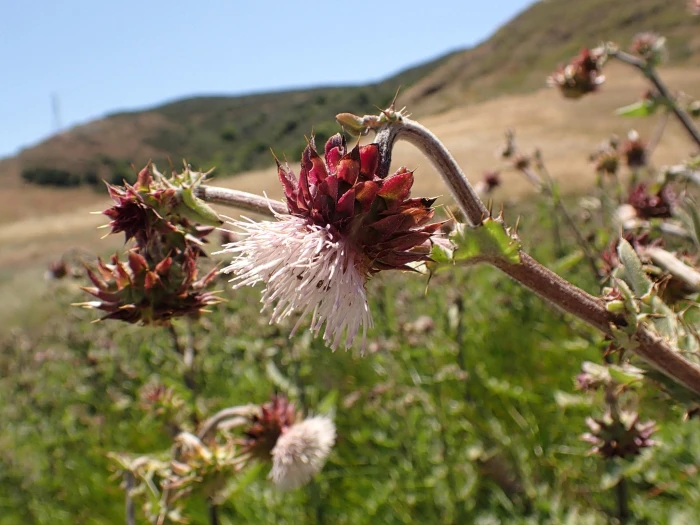Fountain Thistle
(Cirsium fontinale)
Fountain Thistle (Cirsium fontinale)
/
/

Madeleine Claire
CC BY 4.0
Image By:
Madeleine Claire
Recorded By:
Copyright:
CC BY 4.0
Copyright Notice:
Photo by: Madeleine Claire | License Type: CC BY 4.0 | License URL: http://creativecommons.org/licenses/by/4.0/ | Rights Holder: Madeleine Claire | Publisher: iNaturalist | Date Created: 2023-05-27T13:06:03-07:00 |























Estimated Native Range
Climate Requirements
| • Precipitation | 52" - 62" |
| • High Temp. | 75°F - 90°F |
| • Low Temp. | 36°F - 41°F |
Summary
Cirsium fontinale, commonly known as Fountain Thistle, is a perennial herb endemic to California, specifically adapted to wet habitats such as serpentine seeps and streams within the Coast Ranges. It can reach up to 7.2 feet in height, with erect, spiny stems and deeply lobed leaves. The plant is notable for its inflorescences, which bear flowers ranging from white to pink or lavender, blooming from late spring to early summer. The flowers are typically hemispheric or bell-shaped and are attractive to a variety of pollinators.
Fountain Thistle is appreciated for its unique aesthetic and ecological value, particularly in native plant gardens and restoration projects. It is a species of concern for conservationists due to its limited range and specialized habitat requirements. In cultivation, it requires conditions that mimic its natural wetland environment, including consistently moist soil and full sun to partial shade exposure. While not commonly found in general horticulture, it serves as an important genetic reservoir for restoration and educational purposes. There are three recognized varieties: Cirsium fontinale var. campylon in Santa Clara, Alameda, and Stanislaus Counties; Cirsium fontinale var. fontinale in San Mateo County; and Cirsium fontinale var. obispoense, known as the Chorro Creek bog thistle, in the Santa Lucia Mountains of San Luis Obispo County. The species is endangered, with habitat loss being the primary threat, and it requires careful management to prevent further decline.CC BY-SA 4.0
Fountain Thistle is appreciated for its unique aesthetic and ecological value, particularly in native plant gardens and restoration projects. It is a species of concern for conservationists due to its limited range and specialized habitat requirements. In cultivation, it requires conditions that mimic its natural wetland environment, including consistently moist soil and full sun to partial shade exposure. While not commonly found in general horticulture, it serves as an important genetic reservoir for restoration and educational purposes. There are three recognized varieties: Cirsium fontinale var. campylon in Santa Clara, Alameda, and Stanislaus Counties; Cirsium fontinale var. fontinale in San Mateo County; and Cirsium fontinale var. obispoense, known as the Chorro Creek bog thistle, in the Santa Lucia Mountains of San Luis Obispo County. The species is endangered, with habitat loss being the primary threat, and it requires careful management to prevent further decline.CC BY-SA 4.0
Plant Description
- Plant Type: Herb
- Height: 1-3 feet
- Width: 1-2 feet
- Growth Rate: Moderate
- Flower Color: Pink, Purple, White
- Flowering Season: Spring, Summer, Fall
- Leaf Retention: Deciduous
Growth Requirements
- Sun: Full Sun, Part Shade
- Water: Medium
- Drainage: Medium
Common Uses
Bee Garden, Butterfly Garden, Low Maintenance, Water Garden
Natural Habitat
Wet habitats such as serpentine seeps and streams within the California Coast Ranges
Other Names
Common Names: Santa Clara Thistle
Scientific Names: Cirsium fontinale, Carduus fontinalis, Cnicus fontinalis
GBIF Accepted Name: Cirsium fontinale